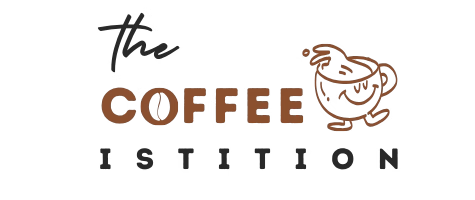
Choosing between hot chocolate and coffee can feel like deciding between comfort and a quick energy boost. Hot chocolate delivers a mild lift—around 5–25 mg of caffeine per cup—while coffee typically offers 80–100 mg. If you’re sensitive to stimulants or want to avoid jitters, hot chocolate often feels gentler. Yet for many, the stronger wake-up call of coffee is unbeatable.
In this guide, you’ll find clear caffeine comparisons, explore how cacao and coffee beans affect your body differently, and discover simple ways to pick the right drink for any occasion. Whether you’re easing into your morning or winding down after work, you’ll learn which cup works best for your routine.
How Much Caffeine Is in Hot Chocolate vs Coffee
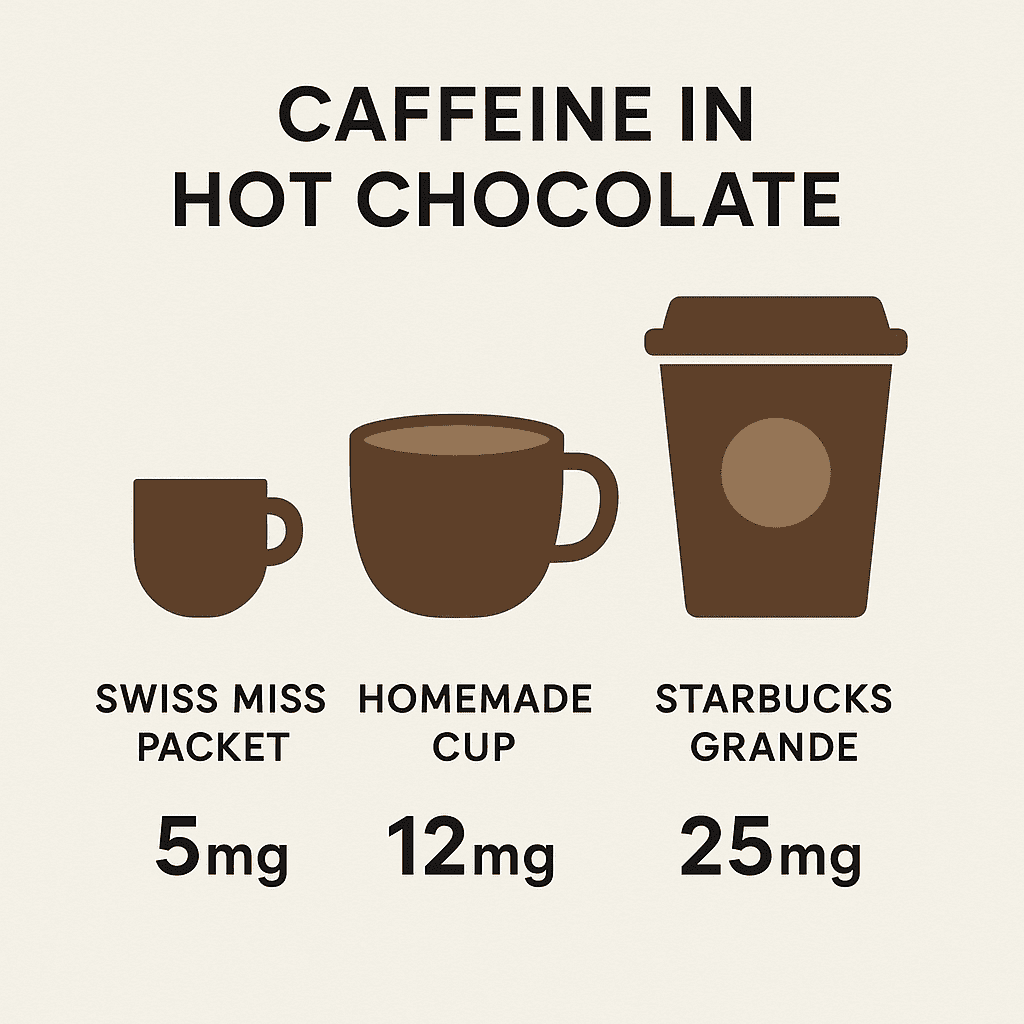
Caffeine Levels in Popular Hot Chocolate Brands vs Coffee
Hot chocolate delivers a much lighter caffeine boost than coffee, making it ideal when you want comfort without overstimulation.
Homemade hot chocolate clocks in at about 12 mg of caffeine per 8-oz serving, while Swiss Miss packets contain just 5 mg. Even Starbucks’ Grande hot chocolate only reaches 25 mg in 16 oz.
Coffee, by contrast, packs a punch:
These numbers show coffee delivers roughly three to eight times more caffeine than hot chocolate, depending on the variety.
Why the Dramatic Difference
Coffee beans naturally pack far more caffeine than cacao beans. When you brew coffee, hot water pulls out most of that caffeine, giving you a substantial boost. Cacao, on the other hand, contains both caffeine and theobromine but in much smaller amounts.
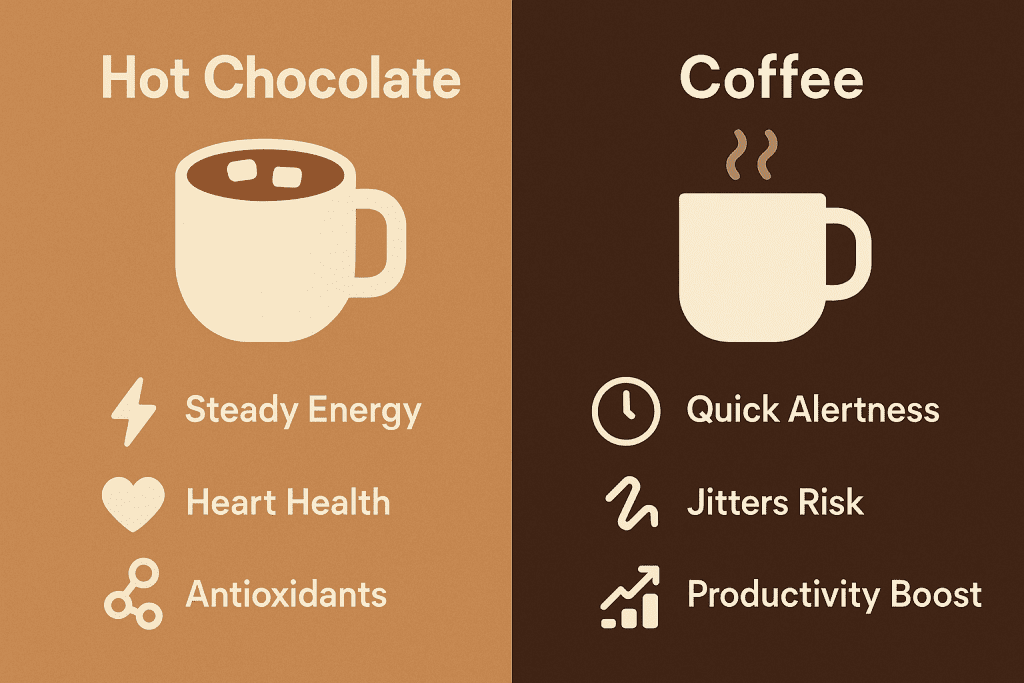
Comparing Energy and Health Benefits of Hot Chocolate and Coffee
Another factor is dilution. Hot chocolate recipes typically combine cocoa powder with a generous amount of milk or water. That extra liquid spreads out the caffeine, so each sip feels milder. Coffee makers focus on squeezing every bit of caffeine from the beans, often using little added water or milk. That’s why a cup of coffee delivers a much sharper kick compared to a comforting mug of hot chocolate.
Factors That Affect Caffeine Levels
Different ingredients and methods change how much caffeine ends up in your cup.
The key factors include:
Use these insights to tweak your next mug’s strength exactly how you like it.
Health Effects and Safety Considerations
Your choice of hot chocolate or coffee does more than perk you up. These drinks act differently in your body, affecting everything from heart rate to sleep quality.
Caffeine vs Theobromine Effects
The key difference lies in their stimulants. Hot chocolate delivers both caffeine and theobromine, while coffee relies almost entirely on caffeine.
Blending caffeine and theobromine gives hot chocolate a gentler profile. You still feel awake, but your nervous system isn’t pushed as hard.
Daily Caffeine Limits by Age Group
Kids and adults have very different caffeine tolerances. Staying within these limits helps you—and your family—enjoy hot chocolate or coffee safely.
|
Age Group
|
Recommended Max Daily Caffeine
|
Example Equivalents
|
|---|---|---|
|
Under 4 years |
0 mg |
none |
|
4–6 years |
45 mg |
1 cup Swiss Miss hot chocolate |
|
7–9 years |
60 mg |
1½ cups homemade hot chocolate |
|
10–11 years |
85 mg |
2 cups homemade hot chocolate |
|
12–18 years |
100 mg |
1 small brewed coffee |
|
Adults (18+) |
400 mg |
4–5 cups brewed coffee |
|
Pregnant women |
200 mg |
2 cups brewed coffee |
These guidelines help you choose the right drink for each family member. If you’re pregnant or sensitive to caffeine, aim for hot chocolate or decaf options to stay well below your limit.
Benefits of Choosing Hot Chocolate
Opting for hot chocolate can be a game-changer if you’re sensitive to caffeine.
These perks make hot chocolate a tasty treat that also nourishes your body, whether you’re winding down after work or craving a midday pick-me-up.
Age-Specific Recommendations and Safety Guidelines
Your age and life stage matter when picking between hot chocolate and coffee. Here’s what to consider at different stages.
Children and Hot Chocolate Safety
Hot chocolate beats coffee hands down for kids. With just 5–25 mg of caffeine, children can enjoy warm drinks without hitting dangerous limits. A Swiss Miss packet has only 5 mg—well under the 45 mg limit for kids aged 4–6.
Watch out for hidden caffeine sources:
Kids’ smaller bodies process caffeine differently. Too much can cause vomiting, confusion, or even hallucinations. Hot chocolate keeps them safe while giving them a tasty treat.
Pregnancy and Caffeine Considerations
Pregnant women should stick to hot chocolate when craving something warm. A typical cup uses only 5–25 mg of the 200 mg daily limit recommended during pregnancy.
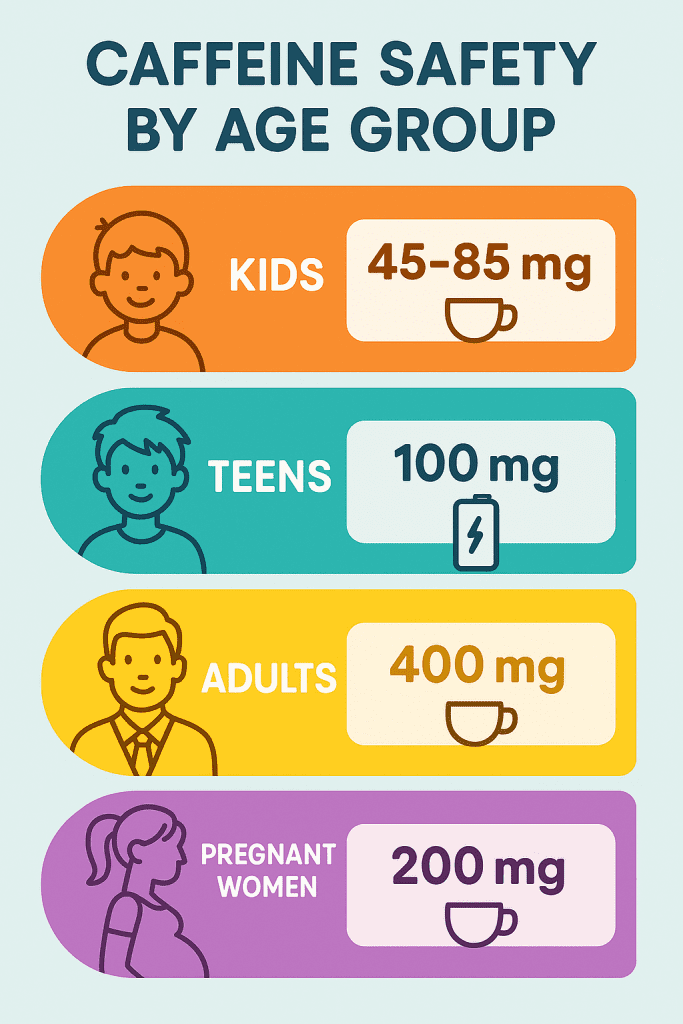
Safe Daily Caffeine Limits by Age Group
Caffeine crosses the placenta and affects your baby. High amounts can increase risks of:
Hot chocolate satisfies cravings while keeping you and your baby safe.
Elderly and Caffeine Sensitivity
Older adults often become more sensitive to caffeine as their metabolism slows. Hot chocolate’s gentle lift is more effective than coffee’s intense jolt.
Age-related factors to consider:
Hot chocolate provides warmth and comfort without putting extra stress on your system.
Brand Comparisons and Product Analysis
Different brands pack varying amounts of caffeine into their hot chocolate. Understanding these differences helps you select the right product for your specific needs.
Popular Hot Chocolate Brands
Swiss Miss keeps caffeine ultra-low at just 5 mg per packet. Their extensive refining process strips out most of the natural caffeine from cocoa. This makes Swiss Miss perfect for kids or anyone wanting minimal stimulation.
Starbucks hot chocolate delivers more punch with 25 mg of caffeine in a Grande size. They use premium cocoa blends that retain more natural caffeine. If you want something more substantial than instant packets but milder than coffee, Starbucks hits the sweet spot.
Homemade hot chocolate falls somewhere in between—usually 5–20 mg depending on your cocoa powder. Natural cocoa powder has more caffeine than Dutch-processed versions, so check labels if you’re trying to control your intake.
Each option serves different goals: Swiss Miss for the gentlest experience, Starbucks for a moderate boost, and homemade for complete control over strength and ingredients.
Coffee Alternatives Comparison
Decaf coffee gives you the familiar taste with minimal caffeine—about 2–5 mg per 8-ounce cup, roughly the same as some hot chocolates. If you crave coffee flavor without the buzz, decaf’s a solid pick.
Cold brew, on the other hand, can contain up to 200 mg per serving. The long steeping process extracts more caffeine, making it one of the strongest coffee options out there.
Specialty espresso-based drinks hide high caffeine levels behind milk and syrups. A latte or cappuccino still delivers the same 63–128 mg found in straight shots, so you’re sipping more caffeine than even the most potent hot chocolate.
Quality Factors Affecting Caffeine
When choosing your cozy cup, consider both flavor and strength. If you want low caffeine with rich taste, lean toward milk-based cocoa or decaf. For a sharper jolt, cold brew or espresso drinks deliver every time.
Making the Right Choice for Your Lifestyle
Your routine, caffeine sensitivity, and health goals determine whether hot chocolate or coffee fits best.
When to Choose Hot Chocolate
Hot chocolate wins if you struggle with jitters or sleep issues from caffeine. Its low 5–25 mg content lets you enjoy a warm drink in the evening without tossing and turning. Families love hot chocolate because kids can join in safely, and its comforting warmth lifts spirits beyond just caffeine.
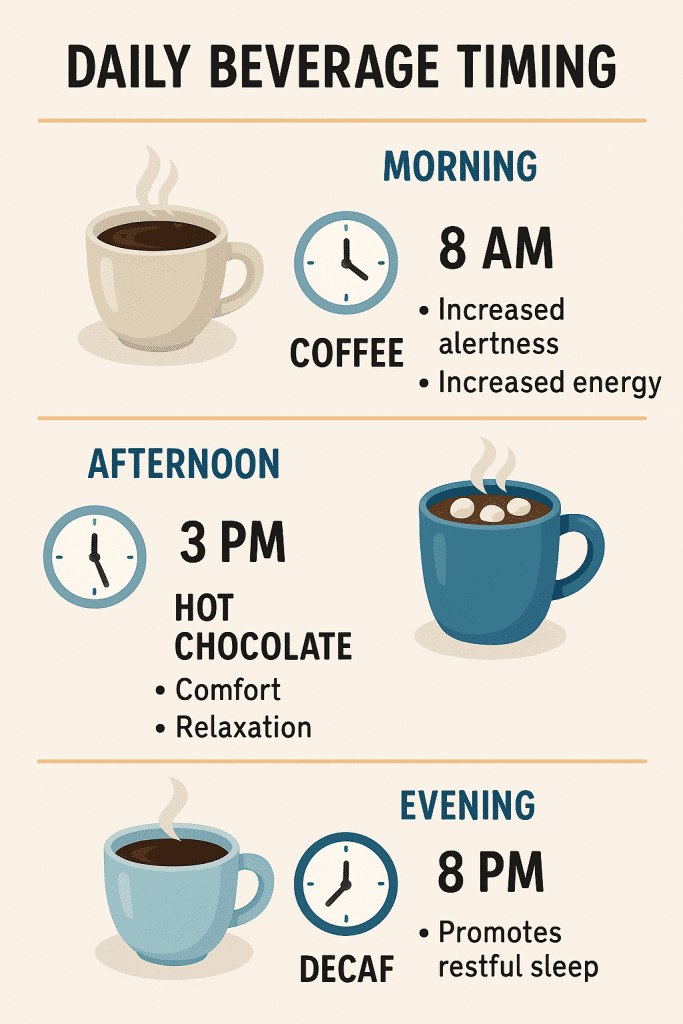
Optimal Timing to Enjoy Coffee, Hot Chocolate, and Decaf Throughout the Day
When Coffee Might Be Better
Coffee shines when you need a serious wake-up call. A morning cup of brewed coffee or espresso sets the tone for a focused workday. If you’re watching calories or sugar, black coffee outperforms sweet hot chocolate. Coffee’s social side also builds connections in professional settings.
Timing Your Sips
Practical Tips and Best Practices
Optimising Hot Chocolate for Health
Reading Labels and Making Informed Choices
Storage and Preparation for Peak Flavor
Expert Insights and Latest Research
Nutritionist Recommendations
Nutritionists stress balance over complete elimination when it comes to caffeine choices. They recommend tracking your total daily caffeine from all sources—drinks, chocolate, medications—to avoid accidental overconsumption. Everyone tolerates caffeine differently, so what works for your friend might leave you jittery.
Hot chocolate gets praise from professionals as a steady energy source that won’t cause crashes, especially for caffeine-sensitive folks. Long-term wellness comes from pairing moderate caffeine with good nutrition, plenty of water, and solid sleep habits.
Recent Scientific Findings
New research on theobromine reveals benefits that extend beyond simply waking you up—it also supports heart health and boosts mood. Unlike caffeine’s sharp peaks and valleys, theobromine provides steadier energy over more extended periods.
Studies reveal huge individual differences in how fast people process caffeine:
Quality cocoa’s anti-inflammatory properties add another health layer beyond its gentle stimulation.
Future Trends and Considerations
Expect to see caffeine-enhanced hot chocolate products targeting people who want moderate stimulation. Health guidelines are shifting from one-size-fits-all to personalized recommendations based on individual needs. Functional beverages that offer benefits beyond basic nutrition are gaining popularity as people seek drinks that do more than just taste good.
Most Common Concerns
Readers frequently ask about safe caffeine levels for kids and how to spot hidden sources in treats and drinks. Evening consumption and its impact on sleep also come up often. Brand and preparation differences can make it hard to know exact caffeine amounts, so people worry about underestimating total intake. Pregnancy prompts questions about which warm drinks are safe and how much caffeine expecting mothers can tolerate.
Conclusion
Choosing between hot chocolate and coffee comes down to your personal needs. Hot chocolate offers a gentle lift with added nutrients and minimal risk for sensitive individuals, children, and pregnant women. Coffee delivers a powerful jolt when you need to stay alert, but can cause jitters and sleep issues if overdone. By understanding caffeine content, age-specific guidelines, and preparation methods, you can pick the right beverage for every situation—whether it’s a cozy family treat or a productivity booster on a busy morning.
